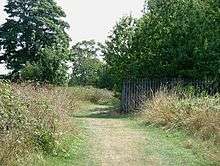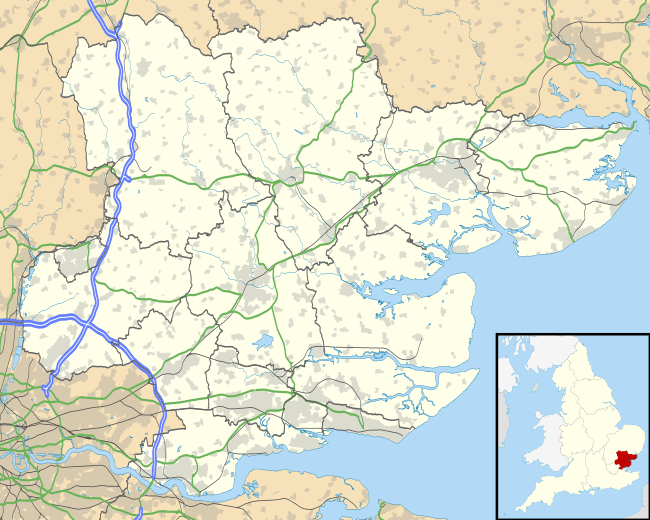Hangman's Wood and Deneholes
| Site of Special Scientific Interest | |
 | |
 Location within Essex | |
| Area of Search | Essex |
|---|---|
| Grid reference | TQ 631794 |
| Coordinates | 51°29′23″N 0°20′52″E / 51.4896°N 0.3477°ECoordinates: 51°29′23″N 0°20′52″E / 51.4896°N 0.3477°E |
| Interest | Biological |
| Area | 3.0 hectares |
| Notification | 1986 |
| Location map | Magic Map |
Hangman's Wood and Deneholes is a 3 hectare biological Site of Special Scientific Interest in Little Thurrock in Essex. The deneholes, which were created by medieval chalk mining, are a Scheduled Monument.[1][2][3]
The name Hangmans Wood dates back to at least the mid 17th century when it was recorded on an estate map.[4] Trees in the wood include oak, ash, sycamore and wild cherry.

The wood contains a number of deneholes which were investigated by the Essex Field Club at the end of the 19th century.[5] There is normally no access to the deneholes, but permission can be obtained from the council.[6] The deneholes are the most important underground hibernation sites for bats in Essex, with three species; Brown long-eared bat, Natterer's bat and Daubenton's bat. The oak woodland is ancient, and it provides a feeding habitat for the bats.[1]
The deneholes in the wood, which were sometimes known as Cunobeline's gold mines,[7] are described by English Heritage as medieval or post-medieval and were used for chalk or flint mining.[8] They are a scheduled ancient monument. The origin of these deneholes is discussed by Tony Benton.[5] There appears to have been more than 70 holes in the wood at one time, concentrated to the north of the wood. Most only survive now as shallow dips in the ground.
The bridlepath which crosses Grangewood Avenue and runs beside Woodside School to connect Hangman's Wood with nearby Terrel's Heath is part of an ancient route from Coalhouse Point in East Tilbury to the bridge or causeway at Aveley.[9]
Notes
- 1 2 "Hangman's Wood and Deneholes citation" (PDF). Sites of Special Scientific Interest. Natural England. Retrieved 1 August 2016.
- ↑ "Map of Hangman's Wood and Deneholes". Sites of Special Scientific Interest. Natural England. Retrieved 1 August 2016.
- ↑ "Dene holes in Hangman's Wood". Historic England. Retrieved 1 August 2016.
- ↑ FG Emmison, ed. (1947). Catalogue of Maps in the Essex Record Office. Essex County Council. p. 6a.
- 1 2 Tony Benton, Boldly from the Marshes
- ↑ The council will issue a descent licence for those who are prepared to abide by a number of simple rules and fill in an insurance slip. The address is: Recreation Manager, Recreation Department, Blackshots Lane, Grays, Essex, RM13 2JU.
- ↑ Thomas Wright (1834), The picturesque beauties of Great Britain
- ↑ Pastscape - Detailed Result: HANGMANS WOOD DENEHOLES
- ↑ Benton, Tony (1991). Boldly from the marshes. Thurrock Council. pp. 86–87.